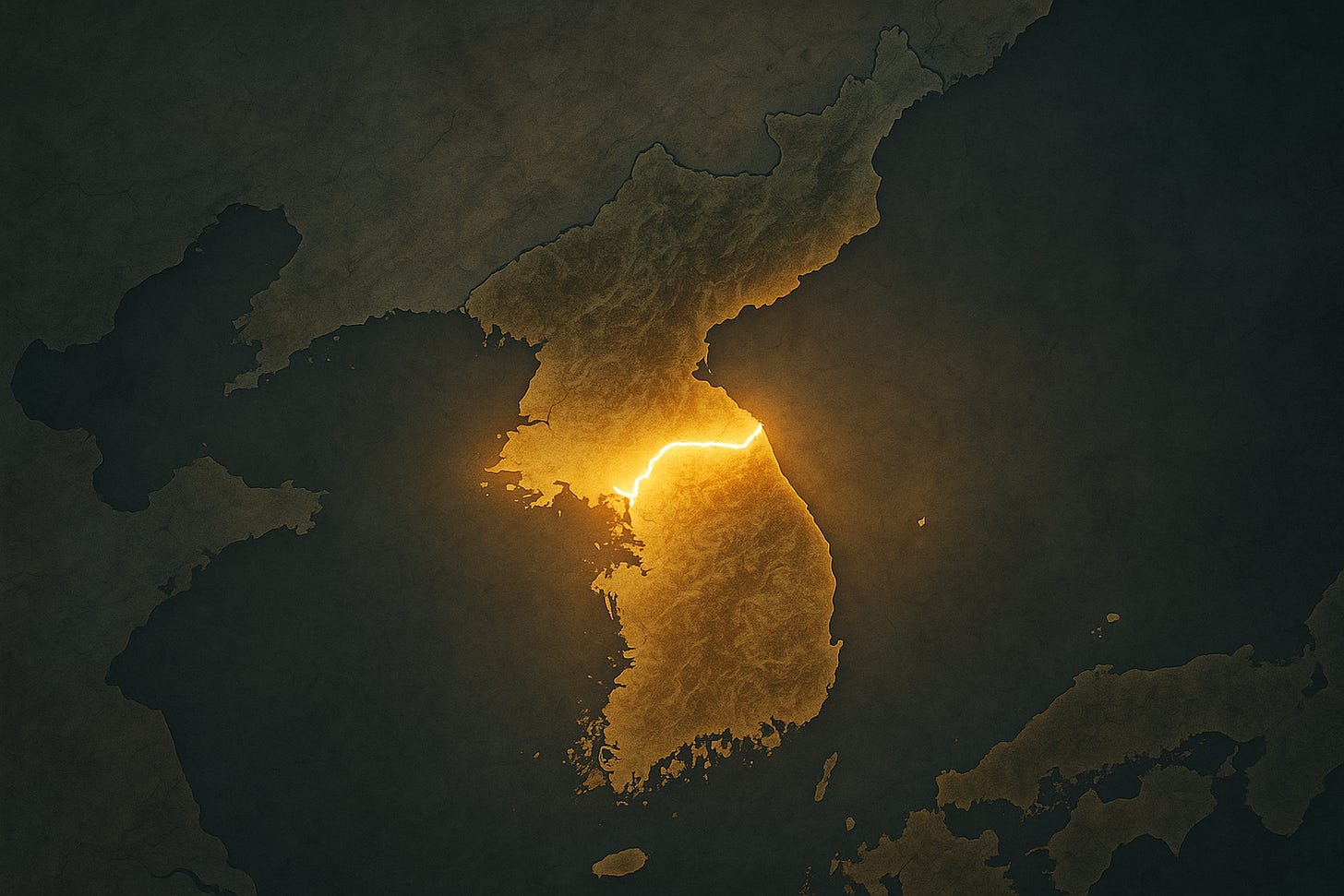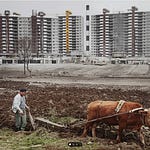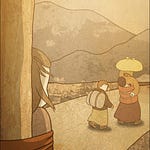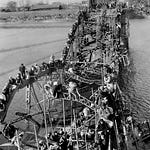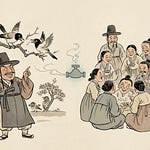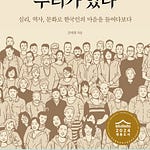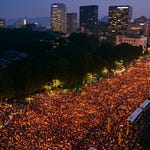From page to Reels: my Substack posts are now videos. Watch on YouTube!
Democracy in the Shadow of Division
Last week, I promised we’d dive into South Korea's wild, inspiring, and sometimes baffling pro-democracy movements.
But before we get to the protests, the impeachments, and the sheer democratic muscle memory of this place, we have to talk about the elephant in the room. Or rather, the Demilitarized Zone that slices the room in half.
Korea is a divided country.
This fact is so fundamental, so all-encompassing, that trying to understand Korean politics without it is like trying to understand Gotham City without mentioning Batman. It just doesn’t work.
A lot of people don’t realize this, but Korea wasn't always divided.
For much of the last 1,300 years, Koreans lived under unified kingdoms, sharing one language and culture. That history of unity—the traditions of scholar-officials checking the king's power, the political philosophy centered on the people's welfare—it doesn't just belong to the South. The North shares that same heritage.
So how did one of the world's oldest unified nations split into two of its most bitter rivals? How did the same historical DNA produce a vibrant, chaotic democracy in the South and a hereditary totalitarian state in the North?
The answer, overwhelmingly, is the division. And to understand South Korea’s democracy, we have to start with how that division began. It wasn’t with an ancient feud. It started in a stuffy Washington office, with two officers, a pencil, and a National Geographic map.
The Night the Line Was Drawn
Late at night on August 10–11, 1945, two U.S. Army officers—Colonel Dean Rusk and Colonel Charles H. Bonesteel—hunched over a National Geographic wall map in a Washington, D.C. office. Japan’s surrender was imminent. Working in haste, in roughly half an hour, they needed a line that kept Seoul in the U.S. zone.
They had never been to Korea. They knew virtually nothing about its history, culture, or geography. But Soviet troops were racing south, and American commanders needed to define where Soviet occupation ended and American occupation began—fast.
So they grabbed a ruler.
They found the 38th parallel—a line of latitude that cut roughly through the middle of the peninsula, keeping Seoul safely in the south. It didn't follow any river, mountain range, or cultural boundary. It sliced arbitrarily through rice paddies, villages, and family farms.
Thirty minutes of pencil work, affecting roughly 28–30 million Koreans. Zero Koreans consulted.
Neither officer realized they'd just drawn what would become one of the world's most heavily militarized borders—a scar that would divide families for generations and shape one of the 20th century's most fascinating democratic experiments.
How to Accidentally Create a Cold War Flashpoint
Here's what makes this story so tragic and absurd: for most of the last millennium, Korea was a unified state. While Europe was busy splitting and merging kingdoms like a medieval game of Risk, Korea maintained remarkable continuity.
But in 1945, Korea was like a patient coming out of a long, traumatic surgery. Thirty-five years of Japanese occupation had been devastating. The occupiers had tried to erase Korean culture, had banned the language in schools, had forced Koreans to take Japanese names, and had conscripted hundreds of thousands as forced laborers and "comfort women."
When Japan surrendered, Korea was free but fragile. The Allies had vague plans. At the 1943 Cairo Conference, they had promised that Korea would become "free and independent"—but only "in due course." Translation: "We'll figure it out later."
Later arrived sooner than expected.
When "Temporary" Becomes "Forever"
The 38th parallel was supposed to be purely administrative. The Soviets would handle the Japanese surrender north of the line, the Americans south of it. Simple. Temporary.
What could go wrong?
Everything, as it turns out.
The Americans and Soviets immediately began setting up completely different systems. With decisive Soviet backing, Kim Il-sung emerged as the northern leader; in the South, U.S. authorities eventually backed Syngman Rhee.
At the Moscow Conference of Foreign Ministers in December 1945, the great powers proposed a "trusteeship" to guide Korea toward self-rule. Protests erupted widely; the Right spearheaded an anti-trusteeship campaign while leftist parties—under Soviet pressure—shifted, by early January 1946, to conditional support. This split over trusteeship wasn't just a policy debate; it became a bitter national divide, deepening the chasm between the left and the right.
The U.S.-Soviet Joint Commission, tasked with creating a unified government, met repeatedly across 1946–47, yet ultimately deadlocked.
By 1947, President Truman tossed the problem to the newly created United Nations. In November 1947, the UN General Assembly created the UN Temporary Commission on Korea (UNTCOK) to supervise peninsula-wide elections; barred from the North, it observed voting in the South on May 10, 1948.
Two Nations, One Tragedy
The results of that southern election led directly to the formation of two states. Syngman Rhee was elected president by the new Assembly on July 20; the Republic of Korea (ROK) was proclaimed on August 15.
Not to be outdone, the North held its own elections and established the Democratic People's Republic of Korea (DPRK) on September 9, with Kim Il-sung as premier.
Suddenly, there were two Koreas, each claiming to be the only legitimate government of the entire peninsula. This was not a recipe for peace.
The War That Never Ended
On June 25, 1950, North Korean forces crossed the 38th parallel in a massive invasion. Declassified Soviet archives reveal that Kim Il-sung had been begging Stalin for permission to attack. Stalin finally approved the attack. While calculations vary in the scholarship, it's clear he badly misread Washington's response.
President Truman sent American troops under the UN flag. When UN forces pushed north and approached the Chinese border, Mao Zedong sent hundreds of thousands of Chinese "volunteers." What started as a Korean civil war became a proxy fight between superpowers.
The war killed an estimated 2 to 3 million people, a devastating toll that represented more than 10% of Korea's entire population at the time. The fighting ended with an armistice—not a peace treaty—on July 27, 1953. A 4-km-wide Demilitarized Zone (DMZ) was created along a new Military Demarcation Line close to, but not identical with, the 38th parallel—about 160 miles (250 km) long.
Technically, the Korean War never ended.
The Democracy That Learned to Fight
So what does this have to do with Korean democracy? Everything.
The constant threat from the North gave South Korean authoritarians a perfect excuse to suppress dissent: "We can't afford democracy during wartime." For decades, any criticism of the government could be labeled "communist" and dealt with harshly.
Yet somehow, South Koreans fought back. They developed unique democratic muscles—mass peaceful protests, constitutional checks, a culture that expects leaders to earn legitimacy through moral authority, not just elections.
The same division that was supposed to make democracy impossible instead created a democracy unlike any other—one that learned to thrive under pressure.
What's Next
We will trace how a country under a ceasefire won its democracy in blood, not as a gift. We will show how rulers used division as an all-purpose excuse, and how citizens broke that logic. We will follow students, workers, and parents who forced power to answer to law, and explain, in plain English, why those hard-won checks still matter. No mythology. No nostalgia. Only how people built a democracy under permanent pressure, and what it takes to keep it.



